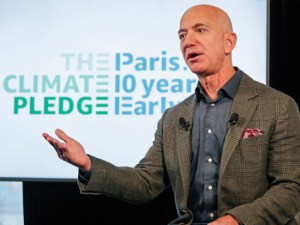Amazon’s Record Renewables Offtake
With a portfolio totaling 6.5 gigawatts, the retail giant has surpassed Google as the world’s largest corporate purchaser of green energy.

Amazon Founder & CEO Jeff Bezos. Image courtesy of Amazon
Online shopping giant Amazon has emerged as the world’s largest corporate purchaser of renewable energy after a massive investment encompassing 26 new wind and solar utility projects across the U.S. and Europe. Following its 3.4-gigawatt buying spree, Amazon’s total renewable energy supply portfolio now amounts to 6.5 GW—eclipsing the next largest purchaser, Google, which reports 5.5 GW of renewable energy purchases under contract around the world.
The 26 utility-scale wind and solar projects announced by Amazon are located in Australia, France, Germany, Italy, South Africa, Sweden, the U.K., and the U.S. On the home front, the retail giant has projects in California, Delaware, Illinois, Indiana, Kansas, Kentucky, Nebraska, North Carolina, Ohio, Texas, and Virginia. Globally, Amazon has 59 utility-scale wind and solar renewable energy projects and 68 solar rooftops installed at fulfillment centers and sort centers around the world.
READ ALSO: Amazon Commits $2B to Clean Energy Fund
Amazon’s 35 major new renewable projects completed in 2020 point at the company’s leadership in the global shift to renewable energy. “Procuring more than 4,000 MW of new renewable power in a single year is an incredible achievement, and it marks big progress toward Amazon’s goal of being powered by 100% renewable power,” said Gregory Wetstone, ACORE president & CEO, in prepared remarks.
The initiative will help the planet stay near greenhouse gas emission reductions that are needed to avoid the worst impacts of climate change, Wetstone added.
“Amazon is helping fight climate change by moving quickly to power our businesses with renewable energy,” said Jeff Bezos, Amazon founder & CEO, in a press statement. “With a total of 127 solar and wind projects, Amazon is now the biggest corporate buyer of renewable energy ever. We are on a path to running 100 percent of our business on renewable energy by 2025—five years ahead of our original target of 2030.”
Pledging for a Net-Zero Future
In 2019, Amazon teamed up with Global Optimism, an environmental change organization, to found The Climate Pledge initiative with the goal of becoming net-zero carbon by 2040. So far, The Climate Pledge has 31 signatories, including BestBuy, The Coca-Cola Co., Microsoft, Rubicon, Siemens, Uber, Unilever, and Verizon, among other corporate giants.
This initiative is tied to the landmark Paris Agreement’s goal to limit global warming to well below 2 degrees Celsius with a target of 1.5 degrees Celsius, which requires global carbon emissions to reach net zero by 2050. It is expected that the U.S., which left the agreement in mid-2017, will re-enter the agreement promptly under the Biden Administration.
Given its size and scale, Amazon aims to set an example for other large companies. To that end, Amazon launched The Climate Pledge Fund in June 2020, with an initial $2 billion to support the development of sustainable and decarbonizing technologies and services to help The Climate Pledge signatories to reach their goals and facilitate the transition to a renewable energy economy.
PODCAST: Committing to Net Zero
A recent United Nations Emission Gap Report—which assesses the gap between anticipated emissions and reductions needed to meet the Paris Agreement goals—warns that, despite worldwide reductions in energy consumption, the 2020 emissions decline of as much as 7 percent will have a “negligible impact on climate change.” That said, the world remains on course to reach a temperature rise above 3 degrees Celsius during this century.
“The year 2020 is on course to be one of the warmest on record, while wildfires, storms, and droughts continue to wreak havoc,” Inger Andersen, executive director of the UN Environmental Programme, noted in the research. “However, UNEP’s Emissions Gap Report shows that a green pandemic recovery can take a huge slice out of greenhouse gas emissions and help slow climate change.”
Andersen urged governments to “back a green recovery in the next stage of COVID-19 fiscal interventions and raise significantly their climate ambitions in 2021.” A green recovery could bring 2030 emissions close to levels needed to meet the 2-degree Celsius goal, with additional steps necessary to reach the 1.5-degree goal.
If governments take action to invest in a green pandemic recovery and follow through with their net-zero commitments, they should be able to bring emissions to levels largely consistent with the 2-degree Celsius goal in time for the next climate meeting in Glasgow in November 2021, the report noted. Furthermore, the world could still reach the 1.5-degree Celsius goal through a combination of green pandemic recovery initiatives and new net-zero commitments followed up with “rapid, stronger action.”







You must be logged in to post a comment.